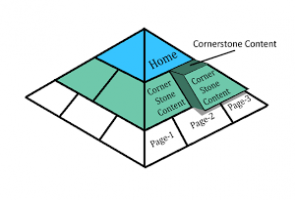It occurred to me recently that I had never tackled the subject of cornerstone content in my blog, so today, I’d like to have a go at it and give you some valuable information that will help make your website more marketable and profitable.
What Is Cornerstone Content?
The first obvious question is, “What the heck is cornerstone content?” The funny thing is, every website has it, but some people (even hardcore marketing pros) don’t do a god job of identifying it or drawing site visitors’ attention to it.
Cornerstone content reflects those things that are essential to your business. Namely, it encompasses basic information about your products or services. Good cornerstone content goes a step further by giving the reader a reason to want to explore further. It’s one thing to simply present a product. It’s quite another to sell it from the moment someone clicks through to your website or landing page.
Elements of Cornerstone Content
To save myself some keystrokes, I’m going to abbreviate “cornerstone content” as CC for the remainder of this article. Results-driven CC has many of the same basic elements that exist in any other kind of content – things like keywords, good titles and headlines, and a high degree of relevance. It draws attention to itself and engages the site visitor as immediately as possible.
The key elements of effective CC lie in the language of the page overall. CC works best when an entire page is dedicated to it. If you want to know how simple it is to present good CC, you need only look at sites like Groupon or Dropbox. They get it right, and they take a very minimalist approach to it. Bear in mind, though, that these sites offer a specific product/service, so if your business is more expansive, your CC will need to be, as well.
The two examples above show how words can do most of the legwork in delivering high-quality CC. This is why, as someone who runs a successful and ever-expanding custom writing company, I am so passionate about doing this right. Words are everything when it comes to good content, and CC is no exception to the rule. With that in mind, let’s take a look at several key elements of CC and discuss why it’s important that each piece is fit into your CC marketing puzzle.
#1 – The Right Keywords
When creating CC, it is vital that you research relevant keywords and use them prominently within the copy. This is good for SEO purposes and also gives your CC the broadest appeal to the widest possible audience. Don’t seed with keywords you think will be effective. Do the research and write copy around what the market wants.
#2 – Epic Titles and Headlines
This is of particular importance with landing pages but your website home page needs to be optimized with at least one stellar CC headline as well. Think of the one concept or message that you feel defines your brand, and zero in on it on the home page. You’ll have a bit more wiggle room on a landing page, but you also don’t want to overdo it. Remember that one of the main characteristics of CC is simplicity. Keep your titles tight, but use power words that compliment your brand message well.
#3 – Unwavering Relevance
Need I emphasize the need for simplicity here again? Make sure that the message in your CC copy is concise and can convey itself within a few seconds of when the page loads. You want the core of your message to be the first thing people see. It also doesn’t hurt to hit them with a call to action as part of the process. Keep them focused on your brand and acclimate them to doing what you want early on in the game. Doing so will almost always lead to higher conversions.
#4 – Powerful Visuals
I’ve had a lot to say about visual content in the past, so I will keep this short and sweet: Use strong images that compliment your brand message. Whenever possible, write the copy around the visuals, not vice-versa. If that isn’t possible, go the custom route and present something that is uniquely yours.
#5 – Links to Related Content
Once you have the reader’s attention, take things further by presenting him or her with ways to learn more. An informed consumer is one who quickly develops trust in your brand and is also far more likely to follow through on a CTA. Here’s the thing, though: All your content has to be of the same caliber or it can quickly backfire on you. Consistency is key.
If you utilize all of these elements when creating CC, the possibility of generating more quality leads and making more conversions increases considerably. I also recommend trying different approaches and A/B testing landing pages to see what kind of information and language appeals to your target audience. Tell your brand story from a number of perspectives, and see which one resonates best with your audience. When you find the right combination, it can translate into the perfect storm for all of your marketing efforts.
